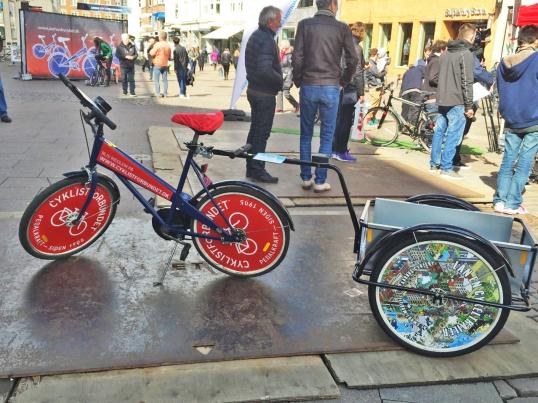- Topic
- Mobility management
- Walking and cycling
- Country
- Denmark
- Resource type
- Case study
First published on 22 July 2020.
In 2016, the City of Aarhus was the first city worldwide to include bike trailers into its city bike scheme which has been operational since 2003.
The scheme started with 20 bike trailers in 2016 and was extended to 50 in for the 2017 season and onwards. This case study has been created as a part of the cities.multimodal project.
Context
The bike trailers as part of the city bike scheme were operational until the end of 2019 when the city bike scheme was shut down in Aarhus. Prior to 2019, in the summer of 2018, 450 city bikes from "Donkey Republic" had de facto replaced the existing municipal city bike system. This left the city with some bike trailers that were unused. as a result, the city decided to poll residents to find out whether they could make use of the bike trailers in a new scheme.
In November 2019, there was a productive dialogue with the community council, and it was decided to try to set up the scheme in the cities.multimodal pilot area. Based on the original idea within the cities.multimodal project about providing bike trailers to residents in the pilot area, it was agreed that the community council of the pilot area would establish a bike trailer rental scheme using four of the 11 bike trailers. This would increase options for the residents to choose other modes of transportation of goods besides the car, hence making a multimodal lifestyle easier in the pilot area.
In action
Implementation of a new scheme was relatively straightforward because a collaborative relationship between the city and the community council was already established. The community council carried out a Facebook poll in December, and easily agreed to establish the scheme because the demand for the bike trailers seemed to be high.
As of the 17 of December 2019, less than one week after the poll was initiated, 121 residents had answered to state that they could see themselves using the scheme, whereas 33 residents didn’t see the need for the scheme. Other than the provision of the trailers and delivery, the City of Aarhus did not have any costs related to this campaign. The scheme was established by the end of February, and there has been little time to follow up on the use. Over the next year, the City of Aarhus will monitor the use of the four bike trailers, using data on loans provided by the community council.
Results
The bike trailers were in general well perceived, and because all of them were GPS equipped, their use could be monitored. They were used for both short and long-distance trips, and in 2016, these 20 trailers were used for around 2,900 kilometres. In the 2017 season with a higher number of trailers, and more visibility the use of the bike trailers exploded, and the trailers were used for a total of 120,000 kilometres over the season.
Challenges, opportunities and transferability
This project serves as a pilot project for other areas. As the City is currently in possession of seven unused bike trailers it will be interesting to see if they can be used for something similar in other places or on a bigger scale in the pilot area. There has been no media coverage of this, as it is considered a very localised measure. When the country is re-opening after the Covid-19 lock-down, the idea is to get in touch with media, also in regard to the mobility points of the area. So far, it has been more important that the residents themselves are aware of the new mobility options in the area. The measures demonstrated the following to the City of Aarhus, which may be able to help others learn from their experience:
- The City does not need to oversee all mobility measures, but can support new mobility services in various ways, i.e. by lending out unused materials to community groups and allow private companies to provide mobility services in public space, i.e. e-scooters and city bikes.
- Identify gatekeepers and enthusiasts in the area. Listen to their ideas, demands, and worries. If you cannot meet their demands by your own means, support them as well as you can in reaching the demands.
- If you want people to use the services and structures that you want to implement, do not implement something unwanted or something that there is no obvious demand for. Be in touch with local community groups to understand their dreams and support them in getting there rather than providing the exact structures they are asking for.
In Depth
This case study was created as a part of the cities.multimodal project and based on a report by guf aarhus [dot] dk (Gustav Friis) Project Manager City of Aarhus – Section of Mobility.
aarhus [dot] dk (Gustav Friis) Project Manager City of Aarhus – Section of Mobility.
This case study has been prepared for the European Commission however it reflects the views only of the authors, and the European Commission is not liable for any consequence stemming from the reuse of this publication.

